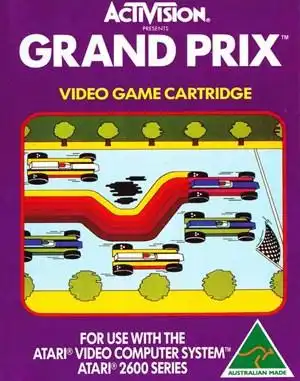The roar of the crowd, the smell of burnt rubber (imagined, of course), the intense focus as you navigate a tricky chicane – few things in gaming capture the pure competitive spirit quite like a Grand Prix. Before photorealistic graphics and complex physics engines, retro games delivered this thrill with pixels, sprites, and sometimes, surprisingly deep simulation.
Whether you were chasing the checkered flag in a top-down view or hurtling around futuristic tracks at impossible speeds, the term "Grand Prix" in retro gaming conjures up a specific kind of challenge and excitement. Let's take a pit stop and look back at some of the classic ways we experienced the ultimate race championship on our old machines.
What "Grand Prix" Meant in the Early Days
Back in the 8-bit and 16-bit eras, "Grand Prix" could mean a few different things. It might refer to:
- A specific racing game title focused on Formula 1 or similar open-wheel racing.
- The championship mode within a broader racing series, where you competed across multiple tracks for points.
- A simulation aiming for some degree of realism, or a purely arcade-style blast.
The variety was huge, reflecting the diverse capabilities of the platforms they appeared on, from home computers like the Spectrum, Amstrad, and C64, to consoles like the SNES.
The Challenging World of Grand Prix Simulator
One title that often springs to mind for fans of early home computer racing is Codemasters' Grand Prix Simulator. This wasn't a game about fancy car upgrades; it was about raw, sometimes frustrating, control.
Seen from a top-down perspective, keeping your pixelated F1 car on the straight and narrow was a challenge in itself, let alone navigating corners. The handling was notoriously slidey, demanding precision that felt almost unfair at times. Yet, for many, mastering its unique physics across its various tracks provided a deeply satisfying, addictive loop.
Different versions existed across platforms like the Amstrad CPC, Commodore 64, ZX Spectrum, and Atari 8-bit. Each had its quirks:
- Amstrad CPC: Often considered the most balanced version, with decent graphics and sound.
- Commodore 64: Featured memorable (and loud!) tire squeal sound effects, different track order, and slightly wider collision detection.
- ZX Spectrum: Could suffer from visual slowdown and attribute clash, sometimes lacking car-to-car collisions.
- Atari 8-bit: Shared similarities with the C64 version in gameplay feel.
Despite their differences and often critical reviews at the time, these versions cemented Grand Prix Simulator as a memorable, albeit difficult, entry in the retro racing canon. The simple graphics belied a tough-as-nails gameplay experience that demanded practice.
Faster, More Furious: Arcade Grand Prix
Not all retro Grand Prix experiences were simulations. On the console front, Nintendo's F-Zero on the Super Nintendo Entertainment System offered a futuristic take on the concept. While not explicitly "Formula 1," its core mode was the Grand Prix – a series of high-speed races across wildly imaginative tracks where boosting, sliding, and surviving were key.
F-Zero was a masterclass in Mode 7 graphics, creating a sense of speed and scale that felt revolutionary. Its difficulty came not from tricky handling on a static track, but from navigating treacherous turns, avoiding mines, and managing your energy shield while battling aggressive AI opponents at breakneck speeds. It was pure, unadulterated arcade adrenaline.
The Dawn of PC Simulation: Geoff Crammond's Grand Prix
For PC gamers seeking a more serious approach, Geoff Crammond's Formula One Grand Prix (known as World Circuit in North America) arrived in the early 90s and set a new standard for racing simulations. This was a game that cared about tire wear, fuel loads, and realistic car setup.
Seen from a cockpit or chase camera view, this game offered a full Formula 1 season experience. Its detailed graphics (for the time) and complex physics engine required patience and skill. It wasn't just about driving fast; it was about strategy, consistency, and mastering each circuit. This game truly embodied the technical and strategic aspects of a real Grand Prix championship.
Why We Still Love These Races
The charm of these retro Grand Prix games lies in their simplicity married with challenging gameplay. They didn't need cutting-edge graphics to deliver excitement. They relied on:
- Addictive mechanics (even the frustrating ones!).
- Memorable sounds and visuals that stick with you.
- The pure goal of being the fastest and winning the championship.
- The satisfaction of finally mastering a difficult corner or beating a tough opponent.
They represent a time when racing games were raw, direct, and often brutally difficult, forging a special bond with players who invested the time to learn their intricacies.
Getting Back on Track: Playing Today
Feeling the need for speed and nostalgia? Many of these classic Grand Prix experiences are still accessible:
- PC Simulations: Games like Geoff Crammond's Formula One Grand Prix often require an emulator like DOSBox to run on modern systems. Some classic racing sims might even pop up on digital storefronts like GOG.com.
- Console Racers: Titles like F-Zero can be played via console manufacturer's online services (like Nintendo Switch Online) or through various emulators available for different platforms (always check local laws and ensure you own the original game).
- 8-bit Classics: Emulators for systems like the Amstrad CPC, C64, and Spectrum are readily available, allowing you to revisit games like Grand Prix Simulator. Websites like Archive.org also host many classic computer games playable directly in your browser (often abandonware).
So fire up your emulator of choice, grab your (virtual) joystick, and prepare to relive the pixelated thrill of the retro Grand Prix!
FAQ
Q: What is Grand Prix Simulator? A: Grand Prix Simulator is a classic top-down Formula 1 style racing game released by Codemasters in the late 1980s for home computers like the C64, Amstrad, and Spectrum. It was known for its challenging, slidey handling.
Q: Can I play F-Zero from the SNES today? A: Yes! The original F-Zero is available on Nintendo Switch Online for subscribers. You can also play it using SNES emulators on various devices.
Q: Are there any realistic retro PC Grand Prix games? A: Absolutely. Geoff Crammond's Formula One Grand Prix (also known as World Circuit) from 1992 is a highly regarded simulation title for PC that offered detailed physics and strategic gameplay for its time. It can often be played using DOSBox.


